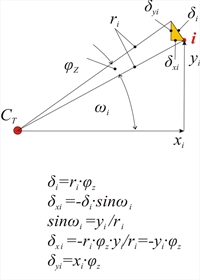|
« Rigid body
Seismic loading model »
|
The 3 displacements δz, φx, φy of each node belonging to the diaphragm are independent of each other, while the rest δx, δy, φz are depended on the 3 displacements of point CT called Center of Elastic Torsion of the diaphragm. Displacements δxi, δyi, φzi at the point i of the horizontal diaphragm are expressed as:  Figure 3.1.4-1: Diaphragmatic function of floor
Figure 3.1.4-1: Diaphragmatic function of floor Figure 3.1.4-1: Diaphragmatic function of floor |  The displacements of a random point i of the diaphragm due to φz
The displacements of a random point i of the diaphragm due to φz The displacements of a random point i of the diaphragm due to φz |
In a floor diaphragm of 20 main and 14 slave nodes, the number of the unknown displacements (degrees of freedom) is equal to 20x3+3=63.
|
« Rigid body
Seismic loading model »
|

|